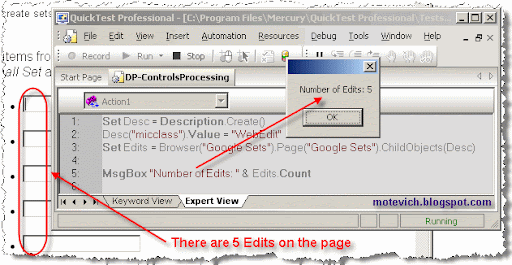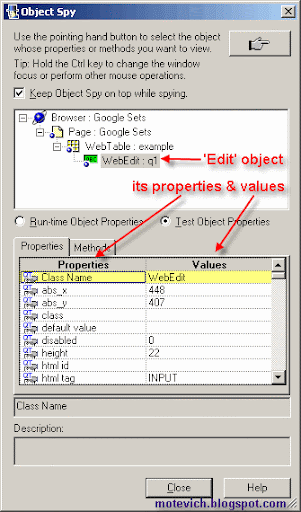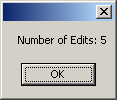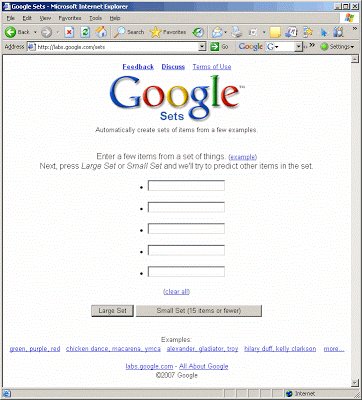
Let’s investigate Descriptive Programming on examples.First of all, we should understand what Descriptive Programming means:
Answer:
QTP DP is a run-time processing of objects which are not located in QTP Object Repository.
I’ve created new QTP script which starts with http://labs.google.com/sets page.
This QTP script is simple enough:
Desc(“micclass”).Value = “WebEdit”
Set Edits = Browser(“Google Sets”).Page(“Google Sets”).ChildObjects(Desc)
MsgBox “Number of Edits: ” & Edits.Count
And its result is: As you can see, it works correctly and returns correct number of Edits on a page.
As you can see, it works correctly and returns correct number of Edits on a page.
I’m going to explain this QTP script and answer the following question:
First of all, I’ve created new Description object:
Description object contains collection of properties, which identify any UI object such as a browser, a page, a dialog, a list, a button etc.
To specify that we want identify all Edits on browser’s page I use “micclass” property:
Note: the “mic” prefix in “micclass” stands for “Mercury Interactive Constant”.
Use Spy for that:
Open QTP object Spy and check recorded properties of object.
For example, these are properties of Edit:
As you can see, there is “Class Name” property and its value – “WebEdit”. So, “WebEdit” is a value of Class Name of all Edits located on Web page.
Note: “Class Name” is a synonym of “micclass”.
I gathered Class Names of Web objects in this table:
| # | Type of Web object | Class Name(micclass) |
| 1 | Web Browser | Browser |
| 2 | Page | Page |
| 3 | Edit box | WebEdit |
| 4 | Image | Image |
| 5 | Link | Link |
| 6 | Web Element | WebElement |
| 7 | Button | WebButton |
| 8 | Checkbox | WebCheckBox |
| 9 | Combobox (DropDownList) | WebList |
| 10 | Table | WebTable |
Since we created Description object for all edit boxes, we can use this description to get all specified objects ( = edit boxes).
The next step returns the collection of all child objects (i.e. edit boxes) contained within the page:
To get the number of found objects in a returned collection, we use Count property:
And the result is 5 found Edits on Google Sets page:
So, this is a mechanism of QuickTest Professional Descriptive Programming.
Also, we can use the same code to get number of others objects – Links, Images, Buttons, etc.
For that I modified QTP script:
Desc(“micclass”).Value = MicClass
Set GetAllSpecificControls = Page.ChildObjects(Desc)
End Function
Function GetAllEdits(Page)
Set GetAllEdits = GetAllSpecificControls(Page, “WebEdit”)
End Function
Function GetAllButtons(Page)
Set GetAllButtons = GetAllSpecificControls(Page, “WebButton”)
End Function
Function GetAllLinks(Page)
Set GetAllLinks = GetAllSpecificControls(Page, “Link”)
End Function
Function GetAllImages(Page)
Set GetAllImages = GetAllSpecificControls(Page, “Image”)
End Function
Set oPage = Browser(“Google Sets”).Page(“Google Sets”)
MsgBox “Number of Edits: ” & GetAllEdits(oPage).Count
MsgBox “Number of Buttons: ” & GetAllButtons(oPage).Count
MsgBox “Number of Links: ” & GetAllLinks(oPage).Count
MsgBox “Number of Images: ” & GetAllImages(oPage).Count
The result of this QTP script is the following:

You can compare the result with the initial web page (see first image in the present article) and verify that QTP Descriptive programming works correctly – it returns correct numbers of objects.
Summary:
- I’ve explained and shown the mechanism of QuickTest Professional Descriptive Programming (QTP DP).
- The present QTP tutorial explains how to get number of different objects – Edits, Links, Images, Buttons, etc.
I hope, that this article has helped you to understand QTP DP.
The future QTP tutorials will cover others questions on QTP Descriptive Programming.


Recent Comments